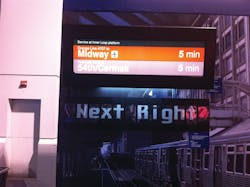When E Ink started making its product that would eventually become the display of e-reader devices, there wasn’t an e-reader market and the technology for the devices didn’t exist, so they started with a different product — signs.
The company made a sign that was placed in a JC Penny’s store in 2000 and eventually the e-reader market developed and E Ink took off. The original sign is now in the E Ink lab but it still works.
Now E Ink is getting back to its roots and building digital signs again with a new partnership with Global Display Solutions, which will bring ultra-thin, ultra-light signs to transit agencies in the U.S.
“This [LCD display] is a power hog while this [E Ink display] is not,” said Michael Ryan, business development manager for GDS while at the Digital Signage Expo. “This display is running off a little power strip.”
Ryan said the E Ink signs not only use less power than LCD signs, but also weigh much less than a traditional LCD display and works well with ambient light. While a 38 inch stretch display shown at DSE was bolted into the wall, the E Ink sign was being held up by some Velcro.
He said they expect the new signs could be utilized well at bus shelters and could be powered with a battery or solar power.
“It’s not very thick at all,” he said. We’ll put it in a little case with some optical bonding glass…and make it vandal resistant.”
Sriram K. Peruvemba, chief marketing officer for E Ink, said the company started a deal with Toppan to launch signs, which have been in service since 2005. After the Japan earthquake of 2011 he said in many cases the E Ink signs were the only ones allowed to run because of their low power consumption.
The technology is so power efficient, Peruvemba said the company is even working on technology to bring E Ink to mobile devices so people can keep their boarding pass or itinerary present on their mobile device without having to worry about finding a WiFi spot and using zero power.
“If you took the battery out of your tablet and put it in an e-reader, now even though that e-reader is rated for two months, it will probably run for six months on a single charge,” Peruvemba said. “Now if you reversed it and put the e-reader battery in the tablet, you wouldn’t make it through chapter one.
“That’s how little power it uses.”
Peruvemba said E Ink states its lifecycle is similar to LCD signs at 50,000 hours, but LCD signs are rated at that lifespan because that’s when the backlight will go out. However, E Ink doesn’t use backlights and there are signs that have been working for 13 years.
“It’s one of the most rugged displays there are,” he said.
Ryan said GDS has just launched the products and will begin rolling it out into the market in the next six months and transit agencies may want to check it out for a new digital sign option.
“You want to see this,” he said. “It costs a heck of a lot less than this [LCD display] and this [LCD display] goes for eight grand.”
About the Author
Joe Petrie
Associate Editor
I came to Mass Transit in 2013 after spending seven years on the daily newsbeat in southeastern Wisconsin.
Based in Milwaukee, I worked as a daily newspaper reporter with the Waukesha Freeman from 2006-2011, where I covered education, county and state government. I went on to cover courts for Patch.com, where I was the main courts reporter in the Metro Milwaukee cluster of websites.
I’ve won multiple awards during the course of my career and have covered some of the biggest political events in the past decade and have appeared on national programs.
Having covered local government and social issues, I discovered the importance of transit and the impact it can have on communities when implemented, supported and funded.

